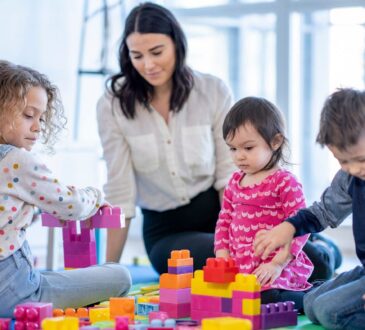
Are you wondering how you can best help your toddler or preschooler learn basic maths skills? Here, we explain how a few simple, playful activities can make a huge difference to your child’s understanding of maths and put them in a great position for starting school.
How is maths taught in nurseries?
Maths should strongly feature in all nursery curriculums. In British curriculum nurseries that will be following the Early Years Foundation Stage (EYFS) curriculum, maths is central. In the EYFS, numeracy is one of the seven interconnected “Specific Areas for Learning and Development” alongside Literacy, Physical Development and others. EYFS guidance describes numeracy as one of the “essential skills and knowledge required by children to participate successfully in society.”
In the nursery curriculum, the full range of early maths skills will be taught. As well as being able to count in the right order, 1:1 correspondence is a vital skill to master. This means knowing that a number is a symbol that represents a quantity of something.
Children will also learn about the concepts of more and less. There are also lessons in shape, space, pattern and measurement to develop early mathematical thinking.
So, how do nurseries teach these important skills? All good nursery practitioners know that young children learn best through play. So, each day there will be a range of activities on offer that encourage your child to learn maths in a hands-on, playful way. You might see children painting numbers and shapes, playing counting games, being encouraged to make patterns with train tracks, playing with measuring cups at the water table, or having fun with counting and pattern in musical activities.
The language of maths
The key to turning these playful activities into the best possible maths learning opportunities is through language. Nursery teachers consistently use, teach and encourage the language of maths during play. Listen to nursery teachers and children, and you’ll hear lots of number and shape words being used: lots, more, fewer, shorter, empty, the names of shapes, and many more.
How can I help my child at home?
There are so many fun activities that nurseries use that you could also set up at home. Just remember that whatever you are doing, using lots of maths language will be really helpful for your child.
Here are a few ideas to try.
-
Baking muffins or cupcakes
Baking a sweet treat is a tried and tested family favourite activity. But, have you ever stopped to think about just how much maths goes into baking? To start, there’s counting and measuring ingredients, timing, pattern making with decorations, and much more.
Muffins and cupcakes are ideal. As well as being good for little hands, the colourful paper cases are so appealing and add in some extra maths opportunities. Here’s how to make the most of your time spent baking:
- Practice 1:1 correspondence and counting when putting the paper cases in the tin. You could also make patterns if you have more than one colour of case.
- Encourage your child to help measure out ingredients, using plenty of maths language as you go, such as “more” or “less.”
- Count out spoonfuls of mixture into the cases and use words like “full” and “empty.”
- Encourage your child to pay attention to the timer and even practice counting backwards as the cakes cook.
- Make patterns with decorations on the finished cake.
-
Sing!
Basic counting is important. Your child needs to learn the names of numbers and the order they come in. Once they can count forwards, they can learn to count backwards, too. There are so many wonderful songs and rhymes to help with this.
Aside from learning maths through music, singing with your child is a wonderful, enriching activity that really promotes good communication. Adding dance and actions enhances physical development, too.
Here are the opening lines to some maths-based favourite songs and rhymes from British nurseries, although you may know many others:
- One, two, three, four, five, once I caught a fish alive
- Hickory, dickory dock, the mouse ran up the clock
- Five little men in a flying saucer
- Five little ducks went swimming one day
- Five little speckled frogs, sat on a speckled log
-
Set up shop
Little kids love to play at being grown-up, so this is always a fun activity to enjoy together. All you need is a little shopping bag or basket, a few coins, and a selection of everyday items from around the kitchen. The contents of the fruit bowl is ideal, as are small tins and packets.
Take it in turns with your child to play shopkeeper and customer. You’ll be amazed at how much mathematical language you can both use in your game, for example:
- Can you count out five apples for me, please?
- I’ll have one more of those, please.
- I have two apples and three oranges. How many pieces of fruit do I have?
- How much is that?
- My basket is full/empty.
As your child progresses in their language and understanding of numbers, you can adapt your mathematical talk and the level of challenge you give them.
Other play opportunities
These are just three ideas. There are so many other ways to play with maths. In fact, nearly every activity you do with your child can involve some maths: count your way up and down the stairs, spot numbers on doors when out and about, count snacks, make shapes and patterns in art and with toys, and read counting stories at bedtime.
Helping your young child understand that maths is all around us will help them grow as confident, able mathematics students, ready for the challenges school brings.
AUTHOR BIO
Ayesha Hoda is a marketing and communications specialist working at Step By Step Nursery Group in the UAE. She holds an MBA degree from a leading business school in Pakistan and has more than 13 years of experience in corporate communications and journalism. She has worked in both agency and client-side roles, designing communication strategies for multinational clients, nonprofits and small businesses in various industries, such as education and healthcare.



